User Testing stands as a fundamental pillar for crafting outstanding digital products in UX Design. It involves observing real users as they interact with a prototype or a website design. This process aims to evaluate the usability, functionality, and overall user experience of a product. By gathering insights directly from users, designers and developers can refine their creations, identify pain points, and make informed decisions that lead to more user-centric designs. Although we will look at it in more depth later, if we want to summarize the goal of user testing in one sentence, it would be that the primary objective of User Testing is to enhance the usability of a product.
Why User Testing
The most obvious reason for conducting user testing is also the most important. Simply put, “you are not the user”. Even if the user knows as much as you do about a particular topic (which is rarely the case), you still know far too much about your own product. You can’t have that “first-time experience” because you have an understanding of how everything works. You need real users to test your product and provide you with the feedback necessary to evaluate the usability of your design. It is not possible for you to evaluate the user experience of your design internally.
Another reason for doing user testing is simply due to its definitive and convincing nature. You will have difficulties persuading some members of your team that a certain feature of the design needs to be changed, when it is based solely on your opinion. Showing real users failing to complete tasks attributed to that feature is clear-cut evidence to motivate everyone in the team to work on that feature. Similarly, it is much easier to persuade management to give you more time or resources to work on a project that looks “good enough”, when you show footage of real users struggling and having an unsatisfactory user experience.

Additionally, you can set up and run a user testing study efficiently and economically these days. So there is really no excuse for not running them. Which reminds me of the 10 silly objections for not performing user testing article that you might want to take a look at later.
You can carry out certain types of user testing in a matter of days with only a few users. There are numerous UX testing platforms available where you can setup your study in minutes. When you are ready, you can share it remotely, and begin your User Testing research in no time! You can sign up for Useberry’s platform for free and begin your first study right after reading this article!
If you still have a hard time convincing certain team members about user testing or if they are not taking the results from small studies seriously, you can find some great tips in this article from the NN Group on Responding to Skepticism About Findings From Small Studies.
User Testing Research Categories
User testing research categories consist of a few binary choices that play an important role in UX research. These choices offer different methods for gathering insights about how users interact with products or services.
Here’s a more detailed exploration of these choices:
- Quantitative vs. Qualitative Research:
- Quantitative Research involves the collection of numerical data and metrics, often through surveys, analytics or UX tools. Quantitative research helps researchers measure user behavior, identify patterns, and make data-driven decisions. It is useful for assessing the frequency of certain actions, such as clicks, page views, or task completion rates. These numbers by themselves might not hold any value, but comparing the results among different designs or against a competitor could be extremely helpful. One of the most powerful aspects of quantitative research comes from the fact that it involves many participants. So the results are statistically significant.
- Qualitative research in general can involve many different methods such as field studies, interviews, focus groups, and diary studies. For UX, it is mainly used for finding usability issues and identifying problems in design. It can be used at any point during the design process or even with a final working product. While quantitative data consists basically of numbers only, qualitative data can be all forms of “findings”. They usually involve very few participants (can be as low as five in some cases). They are also faster and easier to setup than quantitative research studies for the most part. If you would like to learn more about how many users you should have for your study, you might want to take a look at our article on “How to find the right sample size for Qualitative Usability Testing”
- Remote vs. In-person Testing:
- Remote user testing involves participants using a product or website from their own location, often using screen sharing tools. This approach is cost-effective, provides access to a broader and more geographically diverse pool of participants. Remote testing allows researchers to collect feedback in real-world settings. However, it may lack the in-person contextual insights and non-verbal cues that come with physical proximity. Useberry offers tools like Sessions and Video Recordings to overcome some of these drawbacks.
- In-person testing requires participants to be physically present with the researcher or in a lab environment. It enables real-time interactions, immediate probing for insights, and a deeper understanding of facial expressions and body language. In-person testing is particularly useful for complex or sensitive usability studies and when observing physical products or environments. However, it can be time-consuming, more resource-intensive, and limited to participants in a specific location.
- Moderated vs. Unmoderated Sessions:
- Moderated Sessions: In moderated user testing, a researcher or facilitator guides participants through tasks, observes their interactions, asks questions, and provides real-time feedback. This approach allows researchers to clarify doubts, probe for additional insights, and ensure a smooth testing process. Moderated sessions are helpful when researchers need to explore a specific user behavior further, gather detailed feedback, and build rapport with participants.
- Unmoderated Sessions: Unmoderated user testing is self-directed, where participants complete tasks independently without direct facilitation or guidance. Participants typically receive a set of tasks and instructions and use the product or website at their own pace. This approach is efficient and scalable for remote testing, making it suitable for large-scale usability studies. However, unmoderated sessions may lack the ability to address immediate questions. If you are using Useberry’s Participant Pool for your studies, you do have the option to ask a follow-up question to the participants. You need to ask specific questions in a timely manner to ensure that the participants recall what happened during the test. In practice, the choice between these research categories depends on research objectives, budget, timeline, and the specific context of the study. UX researchers often use a combination of these approaches. When combined, you gain a more comprehensive understanding of the user experiences and optimize product designs effectively. Each category offers unique benefits and insights. Researchers should select the most appropriate methods based on the research goals and constraints.
At Useberry, we have a special testing method called Open Analytics, for remote-unmoderated environment! Users can freely explore the site or prototype and self-report when they believe the task is complete. Open Analytics can be used for both formative and summative usability testing. Open Analytics can be used for validating features and getting an organic insight into user journey.
Formative vs. Summative User Testing
Formative and summative testing are two distinct phases in product evaluation, often used in usability and UX research.
Formative Testing is an early stage in the development process, focusing on identifying and addressing usability issues and design flaws to improve the product’s usability, interaction, and overall user experience. It uses qualitative research methods and gathers feedback from stakeholders, target users, designers, and usability experts. The feedback is used to make incremental enhancements to the product, resulting in multiple design iterations.
Summative Testing, on the other hand, occurs later in the development cycle, providing a conclusive assessment of the product’s usability and effectiveness against predefined criteria or benchmarks. It is often required for regulatory compliance or certification in industries like medical devices and automotive manufacturing.
Formative and summative testing are crucial for identifying and addressing usability issues in product design. They serve very distinct purposes in the development cycle.
User Testing = Usability Testing
If we look at it in the literal sense, “user testing” implies that you are testing the users, so any kind of test that involves users can be considered user testing. In the context of UX, however, the term user testing has been used so widely as a replacement for usability testing that we can safely say that they mean the same. So from now on, where we see usability testing, we can assume that we are talking about user testing.
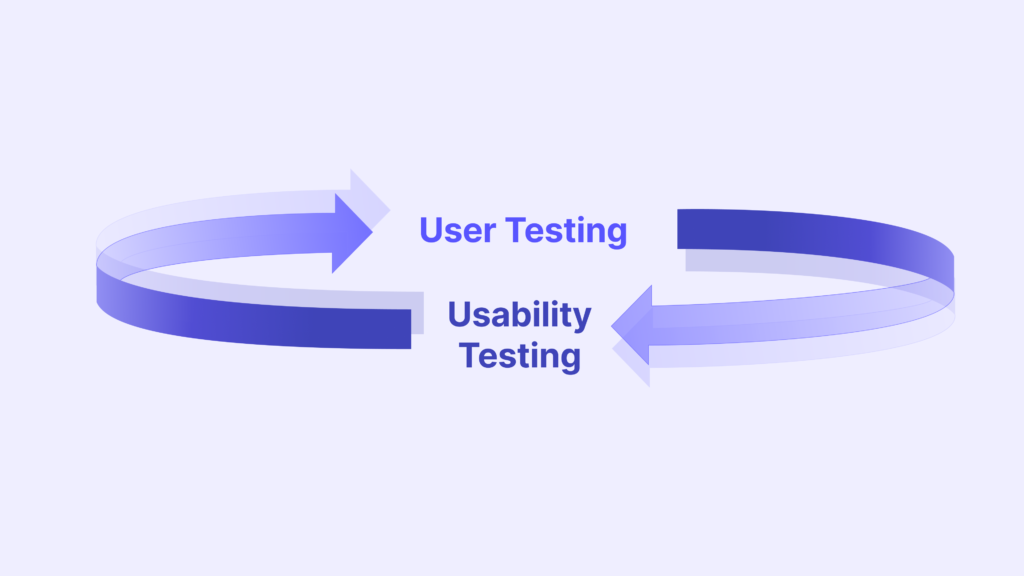
So what is Usability Testing?
Usability testing is a cornerstone of user-centered design, ensuring digital products are intuitive and user-friendly. Its core principle revolves around assessing the ease with which users interact with a product and identifying areas for improvement. You can accomplish a wide variety of objectives, such as pinpointing usability issues, evaluating user flow, gathering feedback, validating design decisions, and measuring user satisfaction.
Usability Testing Goals
Detecting Usability Problems: A primary goal of user testing is to uncover usability issues and problems within a product. This includes identifying navigation difficulties, confusing interface elements, unclear instructions, and any other factors that hinder the user experience. Detecting these problems early allows for timely adjustments and improvements. Finding a good example of a test structure for a specific usability could be difficult. You can take a look at the ready-made Usability Testing Templates that we have prepared to help you get started.
Estimating a Parameter: User testing often aims to estimate parameters such as task completion time. By measuring how long it takes users to perform specific tasks, organizations can assess the efficiency of their product. For example, determining how quickly users can complete a purchase on an e-commerce website helps gauge its effectiveness.
Benchmarking: User testing may involve benchmarking the product against established usability standards or industry best practices. Benchmarking helps assess whether a product meets or exceeds industry standards for usability, which can guide design decisions and set performance goals.
Making Comparisons: User testing can facilitate various types of comparisons, including comparing different versions of a product (e.g., V1 vs. V2) to track improvements or comparing a product to competitors to identify strengths and weaknesses. A/B testing stands out as a widely adopted method for making these kinds of comparisons.
A/B testing involves presenting users with two distinct variations of a design element, such as a button color or layout, to discern which one garners more favorable user responses. By leveraging A/B testing, designers and developers gain empirical insights into user preferences, helping them make data-driven decisions that refine user interfaces and optimize user experiences. This method’s ability to quantitatively measure user interactions makes A/B testing a vital tool in the iterative design process, aiding in continual improvement and enhancing the overall user journey. If you would like to set up your own A/B testing on our platform, you can follow Useberry’s A/B study guide to get started today!
These comparisons provide valuable insights for decision-making and product positioning. You can take a look at our professionally made template for testing two concepts to have a better idea of this goal. A comparative test can be done with a within-subjects design or a between-subjects design, each with its own pros and cons. We will briefly explain the two design principles in the below image:

For UX design, it is important to test for usability at the design and prototype stages of your product, but you can also check the usability of your website to test the live user experience. If you would like to explore Usability testing studies further, I would recommend taking a look at the Website Usability Testing and Task-Based Usability Testing articles as well. You can read on about them further to see how you can be even more effective at User Testing by using these tools.
Essential Tips and Best Practices for Effective User Testing
Navigating the user testing landscape requires a strategic mindset and adherence to key principles. By adhering to the best practices, you equip yourself with a solid foundation for conducting user testing that generates actionable insights, fosters iterative improvement, and contributes to the creation of digital products that truly resonate with your users.
Here are essential tips and best practices to ensure your user testing endeavors yield valuable insights and drive impactful improvements:
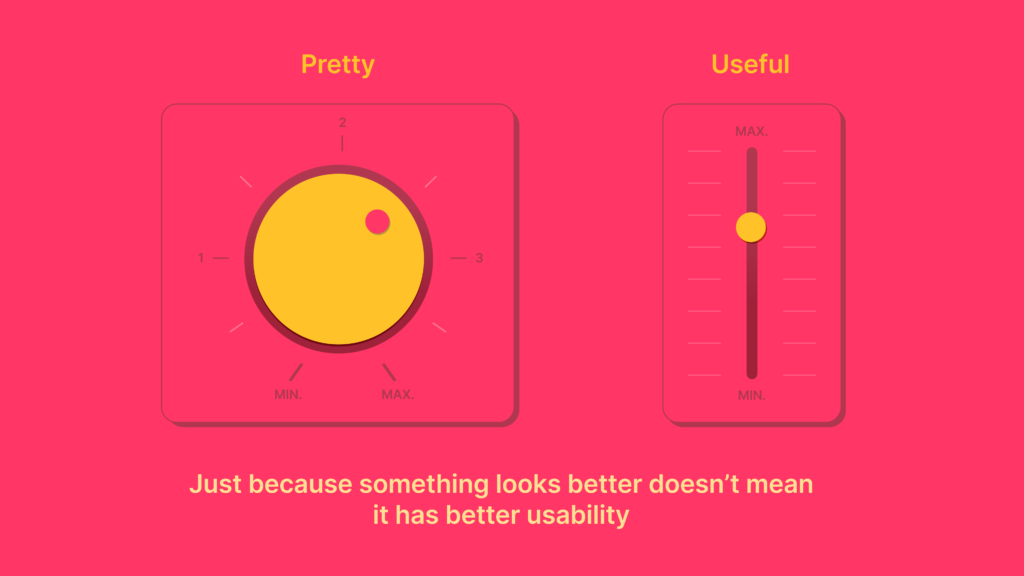
- Not all testing methods work for Usability Testing: One of the most important things that you should realize is that just because a testing method is popular doesn’t mean it will work in the context of Usability Testing. The best example for this is the “Preference Testing” method. Preference testing is a user-focused method that gathers feedback on design elements like color schemes, typography, layout, and visual styles. It helps designers understand user preferences and expectations, enabling them to create interfaces that evoke positive emotions. However, this type of study tests the “look and feel” of a design and not its actual usability. Just because something looks better doesn’t mean it is more functional. Just because a test method is not part of Usability Testing, doesn’t mean it doesn’t have UX research value. If you would like to know more about it and the benefits, we have a Comprehensive Guide on Preference testing!
- Clear Objectives: Define the purpose and goals of your user testing before you begin. Clear objectives guide the entire testing process and ensure you focus on what matters most.
- Diverse Participant Recruitment: Select a diverse range of participants that closely represent your target audience. This inclusivity provides varied perspectives and insights, making your findings more comprehensive.
- We know that testing with the correct target audience could make a huge difference in the effectiveness of your user testing. Useberry’s Participant Pool consists of a large variety of vetted and verified testers with over 100 attributes to choose from across 34 countries that would help you reach the most niche and demanding target groups.
- Realistic Scenarios: Craft scenarios that mimic real-world situations users encounter. By presenting relatable tasks, you encourage natural interactions that reflect genuine user behavior.
- Observation and Listening: Actively observe how participants interact with your product. Pay attention to their actions, hesitations, and verbal feedback. Listening to their thoughts can provide deep insights.
- Iterative Approach: User testing is an iterative process. Continuously incorporate feedback into design iterations and retest to validate improvements.
- Feedback Prioritization: Not all feedback carries the same weight. Prioritize issues based on their impact on user experience and address critical problems first.
- Empathy and Detachment: Approach user testing with empathy for participants’ experiences, but also maintain detachment to objectively analyze findings and make informed decisions.
- Usability Findings & Metrics: Use quantitative metrics, qualitative findings or both to gain a well-rounded view of usability based on how it fits for your goals to gain correct insights..
- Collaborative Insights: Share findings and insights across your design and development teams. Collaborative discussion often leads to innovative solutions and a deeper understanding of user needs. We know the importance of collaboration and communication among teams, so our platform comes with many collaborative features, including a hassle-free way to share the results of your studies.
- Consistency in Testing: Maintain consistency in your testing approach. Using the same scenarios, tasks, and metrics allows for more accurate comparisons across testing sessions. At Useberry, this is another feature that comes with our platform. On top of the ready-made professional UX research templates to run your studies, you can also save your own custom study template to use again in the future!
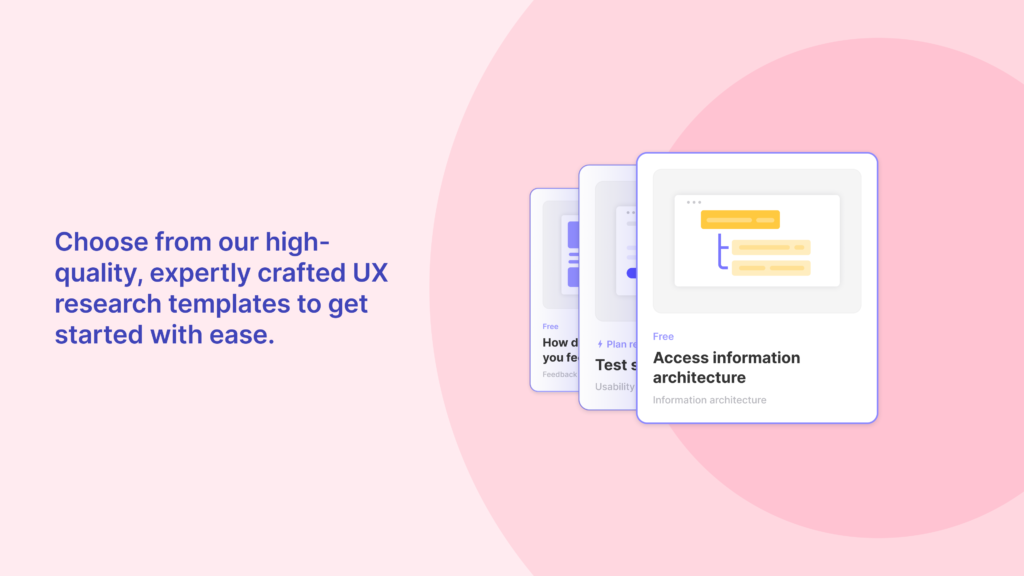
Common Mistakes to Avoid
While user testing is a powerful tool, certain missteps can hinder its effectiveness. By sidestepping the pitfalls and having an objective approach, you can elevate the quality of your user testing and maximize the value of the insights gained. User testing should be a learning experience, not just a confirmation of assumptions. Avoiding these mistakes ensures that your efforts lead to informed design enhancements and exceptional user experiences. Being aware of common mistakes can help you navigate the testing process more successfully:
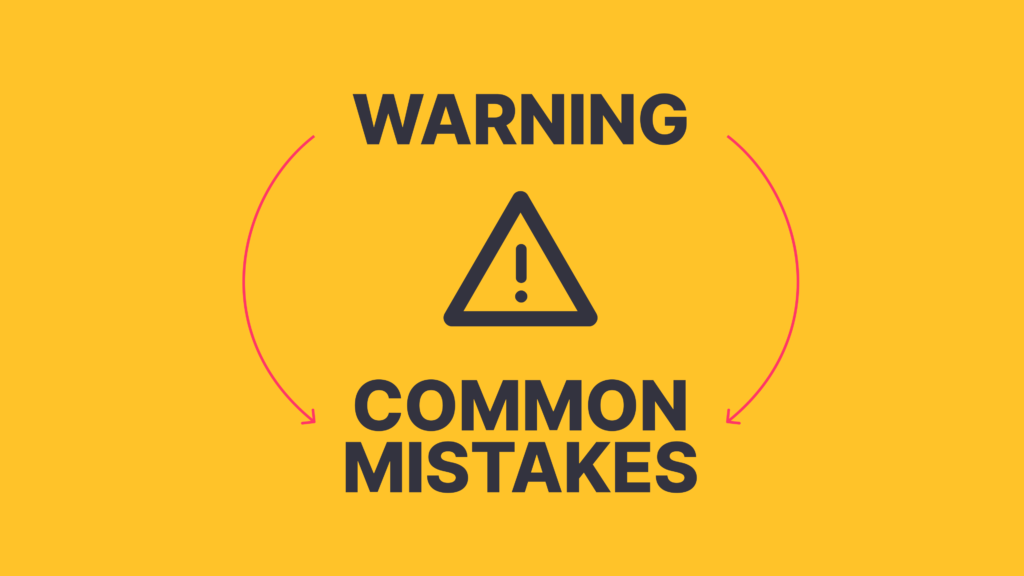
- Bias in Test Design: Designing tests with a specific outcome in mind can skew results. Aim for neutral, unbiased tests that allow users to interact naturally, ensuring accurate insights. There can be other forms of biases that you will encounter in the future during your studies. It is difficult to mention all of them.
- Testing Too Late: Delaying user testing until the later stages of development can be risky. Early testing identifies issues sooner, reducing the need for extensive revisions later on which might be more expensive and time consuming.
- Influencing Participants: Providing leading instructions or hints during testing can distort user behavior. Maintain a neutral stance to prevent influencing their actions.
- Not Documenting Insights: Failing to document test observations, feedback, and findings can result in lost insights. Keep thorough records to inform design decisions and future iterations.
- Ignoring Context: User behavior in testing might differ from real-world use. Consider the context in which the product will be used to contextualize test results.
Incorporating User Testing in Workflow
There are many guides about effective user testing up to the point of analyzing your data and acquiring insights, but not much about how these findings are incorporated into your workflow. The main reason for this is that the process can be significantly different from business to business and it depends on a variety of factors such as the size of your team and business, the UX maturity of your company, business integration among different teams, and availability of time and resources.
In a future article, we will look at how User Testing is integrated into workflow using real-world case examples.
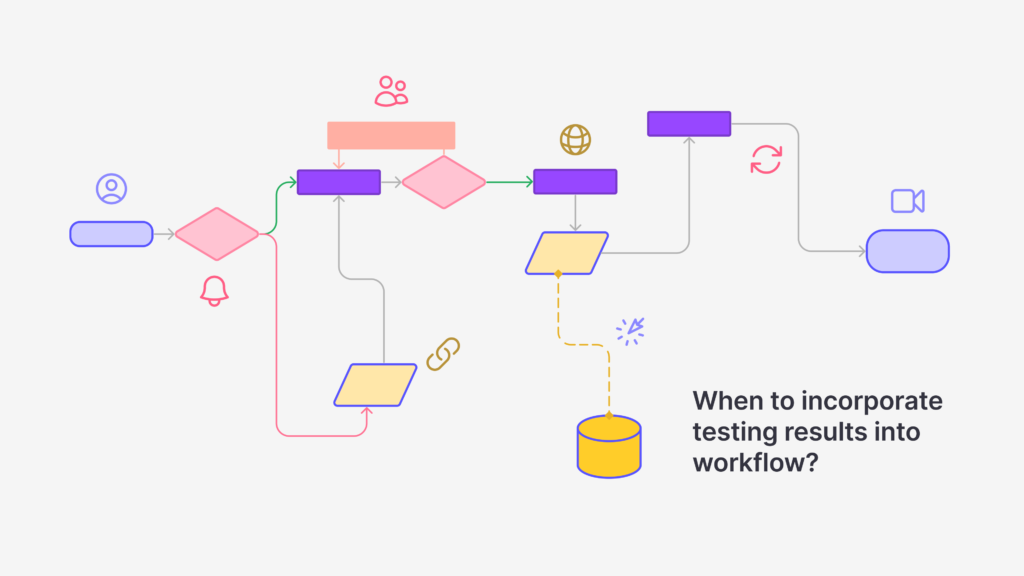
Conclusion
UX designers are expected to produce excellent digital products that offer a top user experience through effective User Testing. You can use the power of user insights to improve and optimize your designs by investigating different user testing techniques, comprehending their roles, and adopting crucial advice and best practices. But it’s also important to stay away from common mistakes that can undermine the success of your testing results. Utilizing User Testing as a continuous process will enable you to create user-centric experiences. This will help you connect with your audience, encourage creativity, and lead to the success of your products as the UX industry continues to develop. So, keep in mind that User Testing is more than simply a stage and requires a dedication to constant improvement.
Are you ready to start your own user testing study?
Sign up to Useberry and start your first study today!




